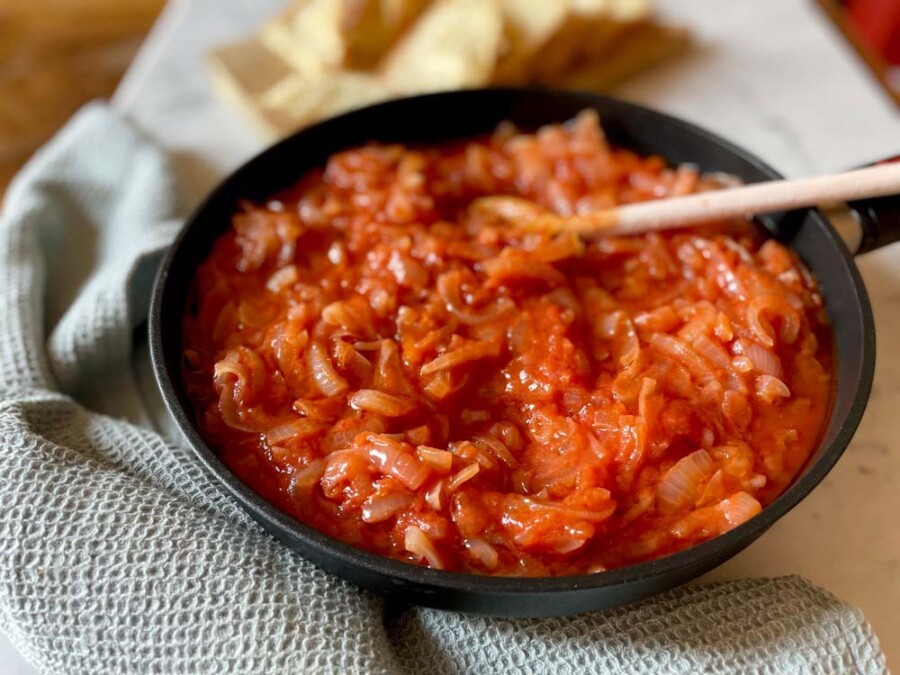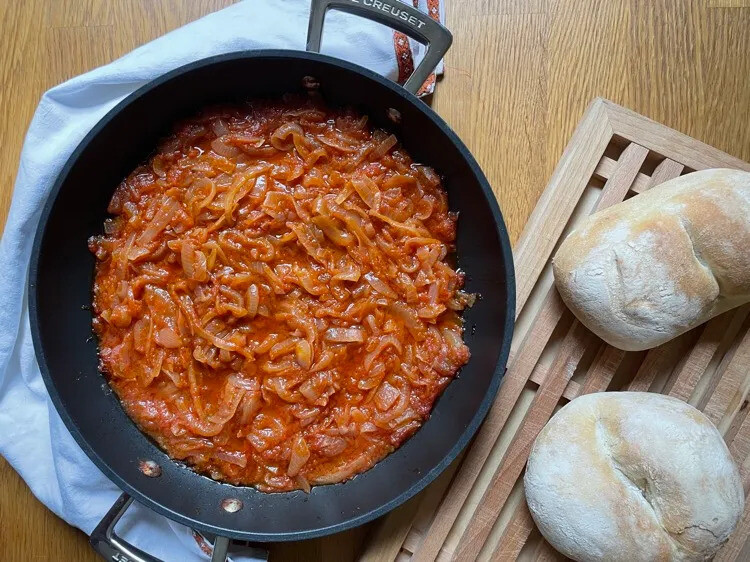Friggione: the heart of Bologna in a sauce

Have you ever heard of friggione?
If you’ve visited Bologna, you probably think of fresh pasta, rich ragù, or maybe even mortadella when it comes to the city’s famous foods.
Friggione is a delightful surprise—a simple yet humble dish that carries a rich history spanning centuries!
Friggione: not just bread and onion
In Italy, there’s a saying: “eating bread and onions” means just getting by.
Yet, in Bologna, onions aren’t just survival food.
They’ve been loved by both peasants and aristocrats since the 14th century. Onions have long played a starring role in Mediterranean cuisine.
From the best restaurants in Venice to the kitchens of Emilia-Romagna, these simple bulbs pop up in recipes across Italy.
But here, in Bologna, the onion’s finest hour is friggione.
What is Friggione?
Friggione is a traditional Bolognese dish made from two key ingredients: onions and tomatoes.
That’s it!
But don’t be fooled by its simplicity. The magic lies in how you cook it, with slow, patient care that transforms basic ingredients into something special.
Friggione has been around for a long time.
The first recorded recipe appeared in the late 1800s, thanks to Maria Manfredi Baschieri, a local woman who lived in the countryside near Bologna.
Although onions have always been considered peasant food, friggione has become a beloved dish across all classes in Bologna—and beyond.

The recipe of Friggione
Ready to dive into making this delicious dish yourself?
Here's the recipe for friggione. It’s surprisingly simple but takes time to let the flavors develop. You’ll need patience and...plenty of onions!
Ingredients
- 1 kg (2.2 lbs) of white onions (preferably from Bologna or Medicina)
- 50 g of brown sugar
- 80 g of olive oil
- 350 g of tomato sauce (or 200 g of canned, peeled tomatoes)
- 5 g of salt
- 100 ml of warm water
- Optional: 50 g of apricot jam or 30 g of caster sugar
- Optional: slices of prosciutto crudo or sausage for extra flavor
Instructions:
- Prep the onions: peel the onions and slice them thinly. If there’s a green core, remove it. Place the onion slices in a large bowl and cover them with cold water. Add half of the sugar and stir. Let them rest for 30 minutes, then drain and repeat the process with the remaining sugar for another 30 minutes.
- Cook the onions: heat olive oil in a deep pan over low heat. Add the drained onions and cook slowly, stirring occasionally, for about an hour with the lid on. The goal is for the onions to soften and release their sweetness.
- Add the tomatoes: once the onions are soft, remove the lid and cook for another 15 minutes to evaporate any excess liquid. Add the tomato sauce, salt, and warm water, stirring everything together. If you like a sweeter flavor, this is the time to add some apricot jam or a little more sugar (a family trick!).
- Simmer: let the friggione cook on low heat for at least another hour, stirring occasionally. If the sauce thickens too much, add a bit more water. Some people like to cook it for up to 2 hours for a deeper flavor.
- Optional prosciutto: if you want to add some extra richness, cut a couple of pieces of prosciutto crudo and toss them into the pan for the last 20–30 minutes of cooking. This gives the dish a salty, savory boost.
- Taste and serve: when the friggione is done, let it rest for a few minutes before tasting and adjusting the salt. Serve it warm, as a side dish, a main course, or even a topping for crostini.
The soul of Bolognese cuisine
Friggione is a perfect example of cucina povera, or peasant cooking, which is all about turning humble ingredients into something truly special.
And that’s why we love it.
In Bologna, friggione is often served as a side dish with meat or spread on crostini for a light antipasto.
But it’s versatile enough to be a sauce for tagliatelle or even enjoyed on its own with some fresh bread to soak up the delicious sauce.
Want a taste?
If this sounds like your kind of dish, why not experience it the right way?
Join us on our Bologna Food Tour, where we’ll introduce you to friggione alongside other local favorites like mortadella and tortellini. It’s a must-try for anyone wanting to dive deep into the culinary heart of Bologna.
Or, if you want to get hands-on with local cuisine, sign up for our Pasta Making Cooking Class. You’ll learn how to make traditional pasta dishes from scratch to pair with friggione!
So, what do you think?
Ready to make some friggione?
With just a few simple ingredients and a bit of patience, you can bring the flavors of Bologna right into your kitchen. Try it once, and you'll find yourself making it again and again.
[photo credits: Monica Campagnoli tortelliniandco.com]


